New Insights into Tyrrhenian Sea Warming and Heat Penetration through Long-Term Expendable Bathythermograph Data
Abstract
:1. Introduction
2. Materials and Methods
2.1. The Study Area
2.2. The Experimental Datasets
2.3. Setting of the Area
2.4. Baseline for Anomaly and OHC Calculations
3. Results
3.1. Temperature Trends and Anomalies
3.2. OHC Trends and Anomalies
3.3. Deep-Water Exchanges through the Sardinia Channel
4. Discussion
5. Conclusions and Perspectives
Author Contributions
Funding
Institutional Review Board Statement
Informed Consent Statement
Data Availability Statement
Acknowledgments
Conflicts of Interest
References
- Pisano, A.; Marullo, S.; Artale, V.; Falcini, F.; Yang, C.; Leonelli, F.E.; Santoleri, R.; Nardelli, B.B. New Evidence of Mediterranean Climate Change and Variability from Sea Surface Temperature Observations. Remote Sens. 2020, 12, 132. [Google Scholar] [CrossRef]
- Lionello, P.; Scarascia, L. The relation between climate change in the Mediterranean region and global warming. Reg. Environ. Chang. 2018, 18, 1481–1493. [Google Scholar] [CrossRef]
- Vargas-Yáñez, M.; Zunino, P.; Benali, A.; Delpy, M.; Pastre, F.; Moya, F.; García-Martínez, M.d.C.; Tel, E. How much is the western Mediterranean really warming and salting? J. Geophys. Res. 2010, 115, C04001. [Google Scholar] [CrossRef]
- Bindoff, N.L.; Willebrand, J.; Artale, V.; Cazenave, A.; Gregory, J.M.; Gulev, S.; Hanawa, K.; Le Quere, C.; Levitus, S. Observations: Oceanic Climate Change and Sea Level. In Climate Change 2007: The Physical Science Basis. Contribution of Working Group I to the Fourth Assessment Report of the Intergovernmental Panel on Climate Change; Solomon, S., Qin, D., Manning, M., Chen, Z., Marquis, M., Averyt, K.B., Tignor, M., Miller, H.L., Eds.; Cambridge University Press: Cambridge, UK; New York, NY, USA, 2007. [Google Scholar]
- Seager, R.; Osborn, T.J.; Kushnir, Y.; Simpson, I.R.; Nakamura, J.; Liu, H. Climate Variability and Change of Mediterranean-Type Climates. J. Clim. 2019, 32, 2887–2915. [Google Scholar] [CrossRef]
- MedECC. Climate and Environmental Change in the Mediterranean Basin—Current Situation and Risks for the Future. In First Mediterranean Assessment Report; Cramer, W., Guiot, J., Marini, K., Eds.; Union for the Mediterranean, Plan Bleu, UNEP/MAP: Marseille, France, 2020; ISBN 978-2-9577416-0-1. [Google Scholar] [CrossRef]
- Pastor, F.; Valiente, J.; Palau, J. Sea surface temperature in the Mediterranean: Trends and spatial patterns (1982–2016). Pure Appl. Geophys. 2018, 11, 4017–4029. [Google Scholar] [CrossRef]
- Shaltout, M.; Omstedt, A. Recent Sea surface temperature trends and future scenarios for the Mediterranean Sea. Oceanologia 2014, 56, 411–443. [Google Scholar] [CrossRef]
- Cheng, L.; Abraham, J.; Trenberth, K.E.; Fasullo, J.; Boyer, T.; Mann, M.E.; Zhu, J.; Wang, F.; Locarnini, R.; Li, Y.; et al. Another Year of Record Heat for the Oceans. Adv. Atmos. Sci. 2023, 40, 963–974. [Google Scholar] [CrossRef]
- Cheng, L.; Abraham, J.; Trenberth, K.E.; Fasullo, J.; Boyer, T.; Locarnini, R.; Zhang, B.; Yu, F.; Wan, L.; Chen, X.; et al. Upper Ocean Temperatures Hit Record High in 2020. Adv. Atmos. Sci. 2021, 38, 523–530. [Google Scholar] [CrossRef]
- Krauzig, N.; Falco, P.; Zambianchi, E. Contrasting surface warming of a marginal basin due to large-scale climatic patterns and local forcing. Nat. Sci. Rep. 2020, 10, 17648. [Google Scholar] [CrossRef]
- von Schuckmann, K.; Le Traon, P.-Y.; Smith, N.; Pascual, A.; Djavidnia, S.; Gattuso, J.-P.; Grégoire, M.; Nolan, G.; Aaboe, S.; Fanjul, E.; et al. Copernicus Marine Service Ocean State Report, Issue 4. J. Oper. Oceanogr. 2020, 13, s1–s172. [Google Scholar] [CrossRef]
- Storto, A.; Masina, S.; Simoncelli, S.; Iovino, D.; Cipollone, A.; Drevillon, M.; Drillet, Y.; von Schuckman, K.; Parent, L.; Garric, G.; et al. The added value of the multi-system spread information for ocean heat content and steric sea level investigations in the CMEMS GREP ensemble reanalysis product. Clim. Dyn. 2019, 53, 287–312. [Google Scholar] [CrossRef]
- Malanotte-Rizzoli, P.; Artale, V.; Borzelli-Eusebi, G.L.; Brenner, S.; Crise, A.; Gacic, M.; Kress, N.; Marullo, S.; D’ALcalà, M.R.; Sofianos, S.; et al. Physical forcing and physical/biochemical variability of the Mediterranean Sea: A review of unresolved issues and directions for future research. Ocean Sci. 2014, 10, 281–322. [Google Scholar] [CrossRef]
- Ciuffardi, T.; Napolitano, E.; Iacono, R.; Reseghetti, F.; Raiteri, G.; Bordone, A. Analysis of surface circulation structures along a frequently repeated XBT transect crossing the Ligurian and Tyrrhenian Seas. Ocean Dyn. 2016, 66, 767–783. [Google Scholar] [CrossRef]
- Krivosheya, V.G. Water circulation and structure in the Tyrrhenian Sea. Oceanology 1983, 23, 166–171. [Google Scholar]
- Millot, C. Circulation in the Western Mediterranean Sea. J. Mar. Syst. 1999, 20, 423–442. [Google Scholar] [CrossRef]
- Vetrano, A.; Napolitano, E.; Iacono, R.; Schroeder, K.; Gasparini, G.P. Tyrrhenian Sea circulation and water mass fluxes in spring 2004: Observations and model results. J. Geophys. Res. 2010, 115, C06023. [Google Scholar] [CrossRef]
- Durante, S.; Schroeder, K.; Mazzei, L.; Pierini, S.; Borghini, M.; Sparnocchia, S. Permanent thermohaline staircases in the Tyrrhenian Sea. Geophys. Res. Lett. 2019, 46, 1562–1570. [Google Scholar] [CrossRef]
- de la Vara, A.; Parras-Berrocal, I.M.; Izquierdo, A.; Sein, D.V.; Cabos, W. Climate change signal in the ocean circulation of the Tyrrhenian Sea. Earth Syst. Dynam. 2022, 13, 303–319. [Google Scholar] [CrossRef]
- von Schuckmann, K.; Le Traon, P.Y.; Smith, N.; Pascual, A.; Djavidnia, S.; Brasseur, P.; Grégoire, M. Copernicus Ocean State Report, Issue 6. J. Oper. Oceanogr. 2022, 15, s1–s220. [Google Scholar] [CrossRef]
- Marullo, S.; Serva, F.; Iacono, R.; Napolitano, E.; di Sarra, A.; Meloni, D.; Monteleone, F.; Sferlazzo, D.; De Silvestri, L.; de Toma, V.; et al. Record-breaking persistence of the 2022/23 marine heatwave in the Mediterranean Sea. Environ. Res. Lett. 2023, 18, 114041. [Google Scholar] [CrossRef]
- Gille, S.T.; Metzger, E.J.; Tokmakian, R. Seafloor Topography and Ocean Circulation. Oceanography 2004, 17, 47–54. [Google Scholar] [CrossRef]
- Artale, V.; Astraldi, M.; Buffoni, G.; Gasparini, G.P. Seasonal variability of gyre-scale circulation in the northern Tyrrhenian Sea. J. Geophys. Res. 1994, 99, 14127–14137. [Google Scholar] [CrossRef]
- Astraldi, M.; Gasparini, G.P. The seasonal characteristics of the circulation in the Tyrrhenian Sea. In Seasonal and Interannual Variability of the Western Mediterranean Sea; Coastal and Estuarine Studies; Geophysical Monograph Series; La Violette, P., Ed.; American Geophysical Union: Washington, DC, USA, 1994; Volume 46, pp. 115–134. [Google Scholar] [CrossRef]
- Astraldi, M.; Gasparini, G.P.; Vetrano, A.; Vignudelli, S. Hydrographic characteristics and interannual variability of water masses in the central Mediterranean: A sensitivity test for long-term changes in the Mediterranean Sea. Deep Sea Res. 2002, 49, 661–680. [Google Scholar] [CrossRef]
- Hopkins, T.S. Recent observations on the intermediate and deep water circulation in the southern Tyrrhenian Sea. Oceanol. Acta 1988, 9, 41–50. [Google Scholar]
- Schroeder, K.; Chiggiato, J.; Bryden, H.L.; Borghini, M.; Ben Ismail, S. Abrupt climate shift in the Western Mediterranean Sea. Sci. Rep. 2016, 6, 23009. [Google Scholar] [CrossRef]
- Sparnocchia, S.; Gasparini, G.P.; Astraldi, M.; Borghini, M.; Pistek, P. Dynamics and mixing of the Eastern Mediterranean outflow in the Tyrrhenian basin. J. Mar. Syst. 1999, 20, 301–317. [Google Scholar] [CrossRef]
- Rhein, M.; Send, U.; Klein, B.; Krahmann, G. Interbasin deep water exchange in the western Mediterranean. J. Geophys. Res. 1999, 104, 23495–23508. [Google Scholar] [CrossRef]
- Iacono, R.; Napolitano, E.; Palma, M.; Sannino, G. The Tyrrhenian Sea Circulation: A Review of Recent Work. Sustainability 2021, 13, 6371. [Google Scholar] [CrossRef]
- Millot, C.; Taupier-Letage, I. Circulation in the Mediterranean Sea. In The Handbook of Environmental Chemistry: Water Pollution; Saliot, A., Ed.; Springer: Berlin/Heidelberg, Germany, 2005; Volume 5, pp. 29–66. [Google Scholar] [CrossRef]
- Napolitano, E.; Iacono, R.; Ciuffardi, T.; Reseghetti, F.; Poulain, P.M.; Notarstefano, G. The Tyrrhenian Intermediate Water (TIW): Characterization and formation mechanisms. Prog. Oceanogr. 2019, 170, 53–68. [Google Scholar] [CrossRef]
- Simoncelli, S.; Reseghetti, F.; Fratianni, C.; Cheng, L.; Raiteri, G. Reprocessing of XBT profiles from the Ligurian and Tyrrhenian seas over the time period 1999–2019 with full metadata upgrade. Earth Syst. Sci. Data Discuss. 2024. preprint. [Google Scholar] [CrossRef]
- Ciani, D.; Rio, M.H.; Menna, M.; Santoleri, R. A synergetic approach for the space-based sea surface currents retrieval in the Mediterranean Sea. Remote Sens. 2019, 11, 1285. [Google Scholar] [CrossRef]
- Reseghetti, F.; Cheng, L.; Borghini, M.; Yashayaev, I.M.; Raiteri, G.; Zhu, J. Assessment of Quality and Reliability of Measurements with XBT Sippican T5 and T5/20. J. Atmos. Ocean. Technol. 2018, 35, 1935–1960. [Google Scholar] [CrossRef]
- Bordone, A.; Pennecchi, F.; Raiteri, G.; Repetti, L.; Reseghetti, F. XBT, ARGO Float and Ship-Based CTD Profiles Intercompared under Strict Space-Time Conditions in the Mediterranean Sea: Assessment of Metrological Comparability. J. Mar. Sci. Eng. 2020, 8, 313. [Google Scholar] [CrossRef]
- Gille, S.T. Float observations of the Southern Ocean: Part 1, Estimating mean fields, bottom velocities, and topographic steering. J. Phys. Oceanogr. 2003, 33, 1167–1181. [Google Scholar] [CrossRef]
- Marshall, D. Influence of Topography on the Large-Scale Ocean Circulation. J. Phys. Oceanogr. 1995, 25, 1622–1635. [Google Scholar] [CrossRef]
- Pinardi, N.; Masetti, E. Variability of the large-scale general circulation of the Mediterranean Sea from observations and modelling: A review. Palaeogeography, Palaeoclimatology. Palaeoecology 2000, 158, 153–173. [Google Scholar] [CrossRef]
- Ribotti, A.; Sorgente, R.; Olita, A.; Orilia, F.; Borghini, M.; Reseghetti, F. Indication of recent warming process at the intermediate level in the Tyrrhenian Sea from SOOP XBT measurements. Mediterr. Mar. Sci. 2016, 17, 467–475. [Google Scholar] [CrossRef]
- von Schuckmann, K.; Le Traon, P.-Y.; Smith, N.; Pascual, A.; Brasseur, P.; Fennel, K.; Djavidnia, S.; Aaboe, S.; Fanjul, E.A.; Autret, E.; et al. Ocean heat content. The Copernicus Marine Environment Monitoring Service Ocean State Report, issue 2. J. Oper. Oceanogr. 2018, 11, s1–s142. [Google Scholar] [CrossRef]
- Palmer, M.D.; Roberts, C.D.; Balmaseda, M.; Chang, Y.-S.; Chepurin, G.; Ferry, N.; Fujii, Y.; Good, S.A.; Guinehut, S.; Haines, K.; et al. Ocean heat content variability and change in an ensemble of ocean reanalyses. Clim. Dyn. 2017, 49, 909–930. [Google Scholar] [CrossRef]
- Liu, W.; Xie, S.P.; Lu, J. Tracking Ocean heat uptake during the surface warming hiatus. Nat. Commun. 2016, 7, 10926. [Google Scholar] [CrossRef]
- von Schuckmann, K.; Gaillard, F.; Le Traon, P.Y. Global hydrographic variability patterns during 2003–2008. J. Geophys. Res. 2009, 114, C09007. [Google Scholar] [CrossRef]
- Schlitzer, R. Ocean Data View 2021. Available online: https://odv.awi.de (accessed on 30 July 2024).
- Jordà, G.; Von Schuckmann, K.; Josey, S.; Caniaux, G.; García-Lafuente, J.; Sammartino, S.; Özsoy, E.; Polcher, J.; Notarstefano, G.; Poulain, P.-M.; et al. The Mediterranean Sea Heat and Mass Budgets: Estimates, Uncertainties and Perspectives. Prog. Oceanogr. 2017, 156, 174–208. [Google Scholar] [CrossRef]
- Schroeder, K.; Gasparini, G.P.; Tangherlini, M.; Astraldi, M. Deep and intermediate water in the western Mediterranean under the influence of the Eastern Mediterranean Transient. Geophys. Res. Lett. 2006, 33, 21. [Google Scholar] [CrossRef]
- Cheng, L.; Abraham, J.; Trenberth, K.E.; Fasullo, J.; Boyer, T.; Mann, M.E.; Zhu, J.; Wang, F.; Locarnini, R.; Li, Y.; et al. Another Record: Ocean Warming Continues through 2021 despite La Niña Conditions. Adv. Atmos. Sci. 2022, 39, 373–385. [Google Scholar] [CrossRef] [PubMed]
- Ben Ismail, S.; Schroeder, K.; Chiggiato, J.; Sparnocchia, S.; Borghini, M. Long Term Changes Monitored in Two Mediterranean Channels. Copernicus Marine Service Ocean State Report 2021, Issue 5; von Schuckmann, K., Le Traon, P.-Y., Eds.; Informa UK Limited, trading as Taylor & Francis Group: Milton Park, UK, 2021; pp. 48–52. [Google Scholar] [CrossRef]
- Escudier, R.; Clementi, E.; Cipollone, A.; Pistoia, J.; Drudi, M.; Grandi, A.; Lyubartsev, V.; Lecci, R.; Aydogdu, A.; Delrosso, D.; et al. A High Resolution Reanalysis for the Mediterranean Sea. Front. Earth Sci. 2021, 9, 1060. [Google Scholar] [CrossRef]
- Margirier, F.; Testor, P.; Heslop, E.; Mallil, K.; Bosse, A.; Houpert, L.; Mortier, L.; Bouin, M.-N.; Coppola, L.; D’Ortenzio, F.; et al. Abrupt warming and salinification of intermediate waters interplays with decline of deep convection in the Northwestern Mediterranean Sea. Sci. Rep. 2020, 10, 20923. [Google Scholar] [CrossRef]
- Vetrano, A.; Gasparini, G.P.; Molcard, R.; Astraldi, M. Water flux estimates in the central Mediterranean Sea from an inverse box model. J. Geophys. Res. 2004, 109, C01019. [Google Scholar] [CrossRef]
- Schroeder, K.; Josey, S.A.; Herrmann, M.; Grignon, L.; Gasparini, G.P.; Bryden, H.L. Abrupt warming and salting of the Western Mediterranean Deep Water after 2005: Atmospheric forcings and lateral advection. J. Geophys. Res. 2010, 115, C08029. [Google Scholar] [CrossRef]
- Roether, W.; Manca, B.B.; Klein, B.; Bregant, D.; Georgopoulos, D.; Beitzel, V.; Kovačević, V.; Luchetta, A. Recent Changes in Eastern Mediterranean Deep Waters. Science 1996, 271, 333–335. [Google Scholar] [CrossRef]
- Tanhua, T.; Hainbucher, D.; Schroeder, K.; Cardin, V.; Alvarez, M.; Civitarese, G. The Mediterranean Sea system: A review and an introduction to the special issue. Ocean. Sci. 2013, 9, 789–803. [Google Scholar] [CrossRef]
- Smith, R.O.; Bryden, H.L.; Stansfield, K. Observations of new western Mediterranean deep water formation using Argo floats 2004–2006. Ocean Sci. 2008, 4, 133–149. [Google Scholar] [CrossRef]
- IPCC. Climate Change 2021: The Physical Science Basis. Contribution of Working Group I to the Sixth Assessment Report of the Intergovernmental Panel on Climate Change; Masson-Delmotte, V., Zhai, P., Pirani, A., Connors, S.L., Péan, C., Berger, S., Caud, N., Chen, Y., Goldfarb, L., Gomis, M.I., et al., Eds.; Cambridge University Press: Cambridge, UK; New York, NY, USA, 2021; p. 2391. [Google Scholar] [CrossRef]
- Borzelli, G.L.E.; Gačić, M.; Cardin, V.; Civitarese, G. Eastern Mediterranean Transient and Reversal of the Ionian Sea Circulation. Geophys. Res. Lett. 2009, 36, L15108. [Google Scholar] [CrossRef]
- Gačić, M.; Borzelli, G.L.E.; Civitarese, G.; Cardin, V.; Yari, S. Can Internal Processes Sustain Reversals of the Ocean Upper Circulation? The Ionian Sea Example. Geophys. Res. Lett. 2010, 37, L09608. [Google Scholar] [CrossRef]
- Gačić, M.; Civitarese, G.; Borzelli, G.L.E.; Kovačević, V.; Poulain, P.-M.; Theocharis, A.; Menna, M.; Catucci, A.; Zarokanellos, N. On the Relationship Between the Decadal Oscillations of the Northern Ionian Sea and the Salinity Distributions in the Eastern Mediterranean. J. Geophys. Res. 2011, 116, C12002. [Google Scholar] [CrossRef]
- Gačić, M.; Civitarese, G.; Kovačević, V.; Ursella, L.; Bensi, M.; Menna, M.; Cardin, V.; Poulain, P.-M.; Cosoli, S.; Notarstefano, G.; et al. Extreme Winter 2012 in the Adriatic: An Example of Climatic Effect on the BiOS Rhythm. Ocean Sci. 2014, 10, 513–522. [Google Scholar] [CrossRef]
- Theocharis, A.; Krokos, G.; Velaoras, D.; Korres, G. An Internal Mechanism Driving the Alternation of the Eastern Mediterranean Dense/Deep Water Sources, in The Mediterranean Sea: Temporal Variability and Spatial Patterns 2014; Borzelli, G.L.E., Ed.; American Geophysical Union/Wiley: Washington, DC, USA, 2014; Volume 202, pp. 113–137. [Google Scholar]
- Placenti, F.; Torri, M.; Pessini, F.; Patti, B.; Tancredi, V.; Cuttitta, A.; Giaramita, L.; Tranchida, G.; Sorgente, R. Hydrological and Biogeochemical Patterns in the Sicily Channel: New Insights From the Last Decade (2010–2020). Front. Mar. Sci. 2022, 9, 733540. [Google Scholar] [CrossRef]
- Gačić, M.; Schroeder, K.; Civitarese, G.; Cosoli, S.; Vetrano, A.; Borzelli, G.L.E. Salinity in the Sicily Channel Corroborates the Role of the Adriatic-Ionian Bimodal Oscillating System (BiOS) in Shaping the Decadal Variability of the Mediterranean Overturning Circulation. Ocean Sci. 2013, 9, 83–90. [Google Scholar] [CrossRef]
- Goni, G.J.; Sprintall, J.; Bringas, F.; Cheng, L.; Cirano, M.; Dong, S.; Domingues, R.; Goes, M.; Lopez, H.; Morrow, R.; et al. More than 50 years of successful continuous temperature section measurements by the global expendable bathythermograph network, its integrability, societal benefits, and future. Front. Mar. Sci. 2019, 6, 452. [Google Scholar] [CrossRef]
- Anderson, E.R. Expendable Bathythermograph (XBT) Accuracy Studies; NOSC Tech. Rep. 550; Naval Ocean System Center: San Diego, CA, USA, 1980; pp. 1–218. [Google Scholar]
- Parras-Berrocal, I.M.; Vazquez, R.; Cabos, W.; Sein, D.V.; Álvarez, O.; Bruno, M.; Izquierdo, A. Dense water formation in the Eastern Mediterranean under global warming scenario. EGUsphere 2023. preprint. [Google Scholar] [CrossRef]
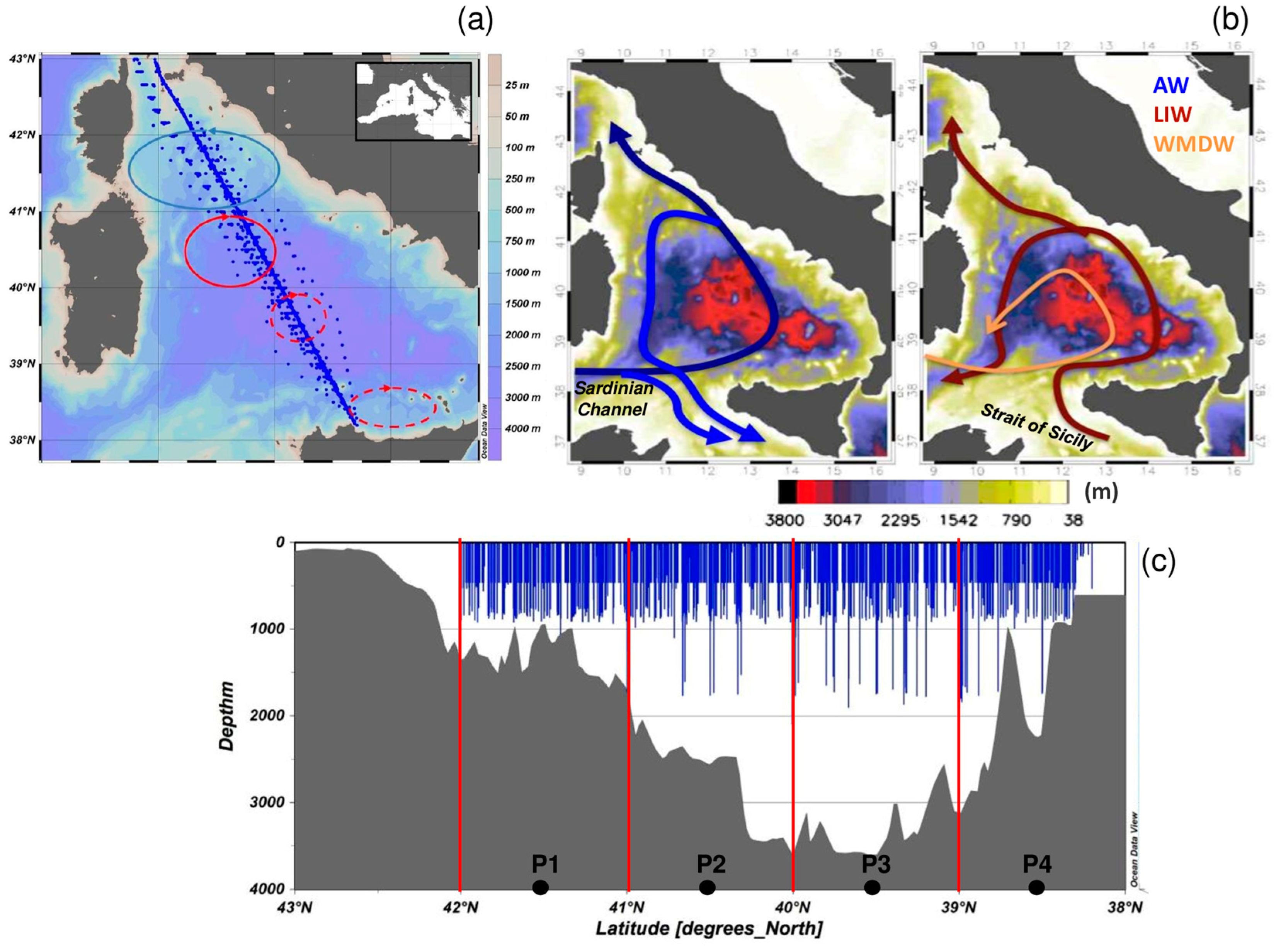
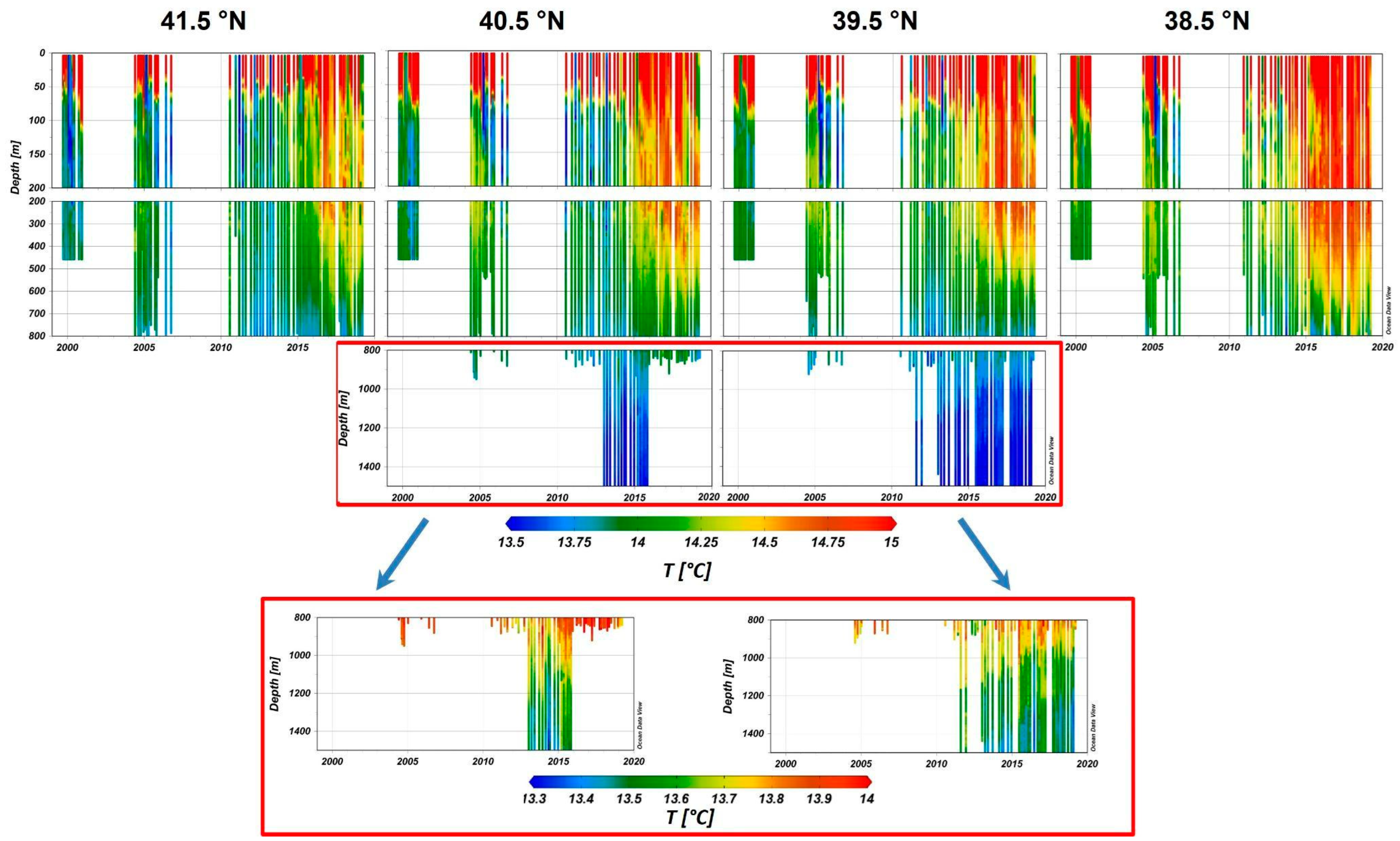

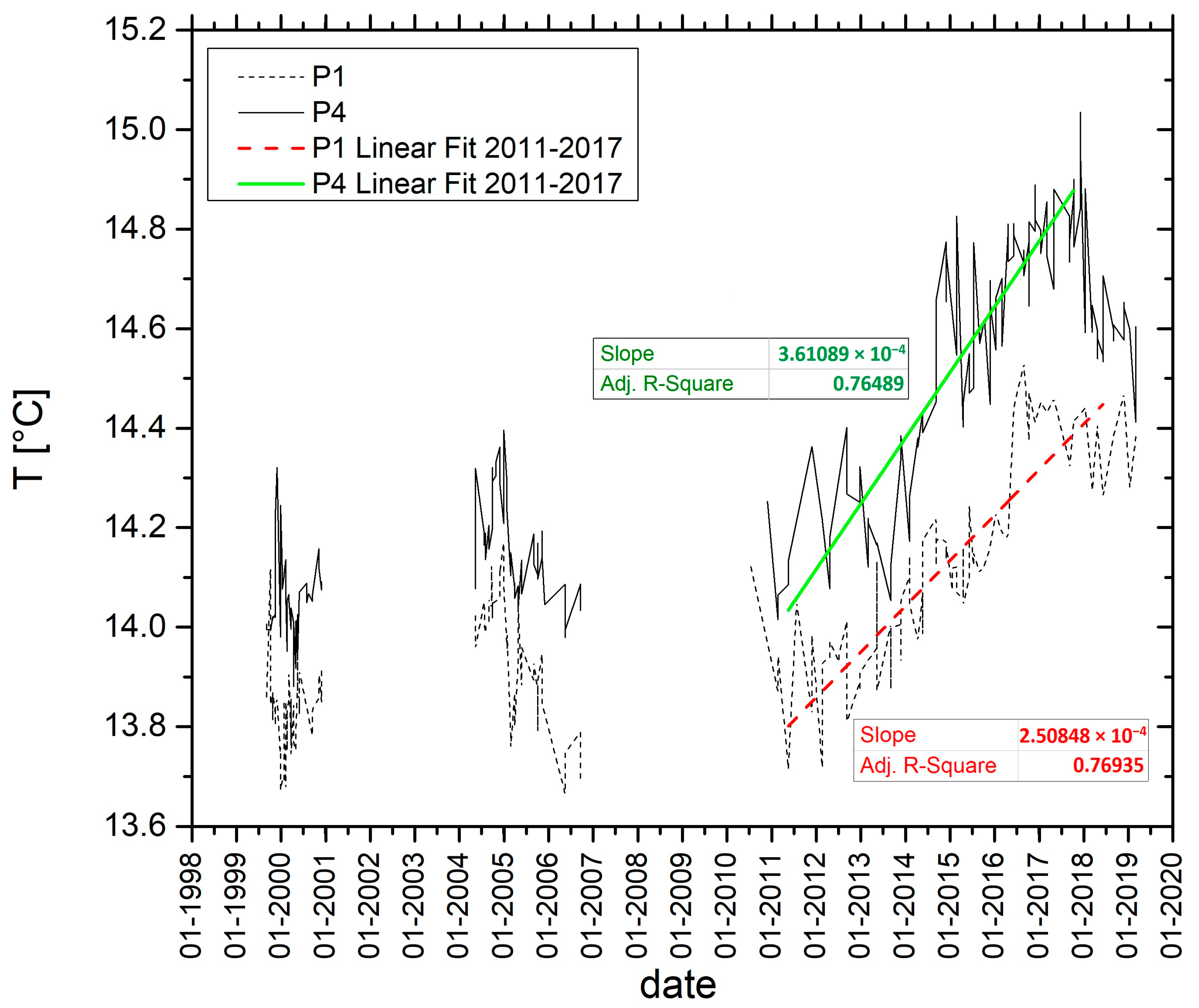
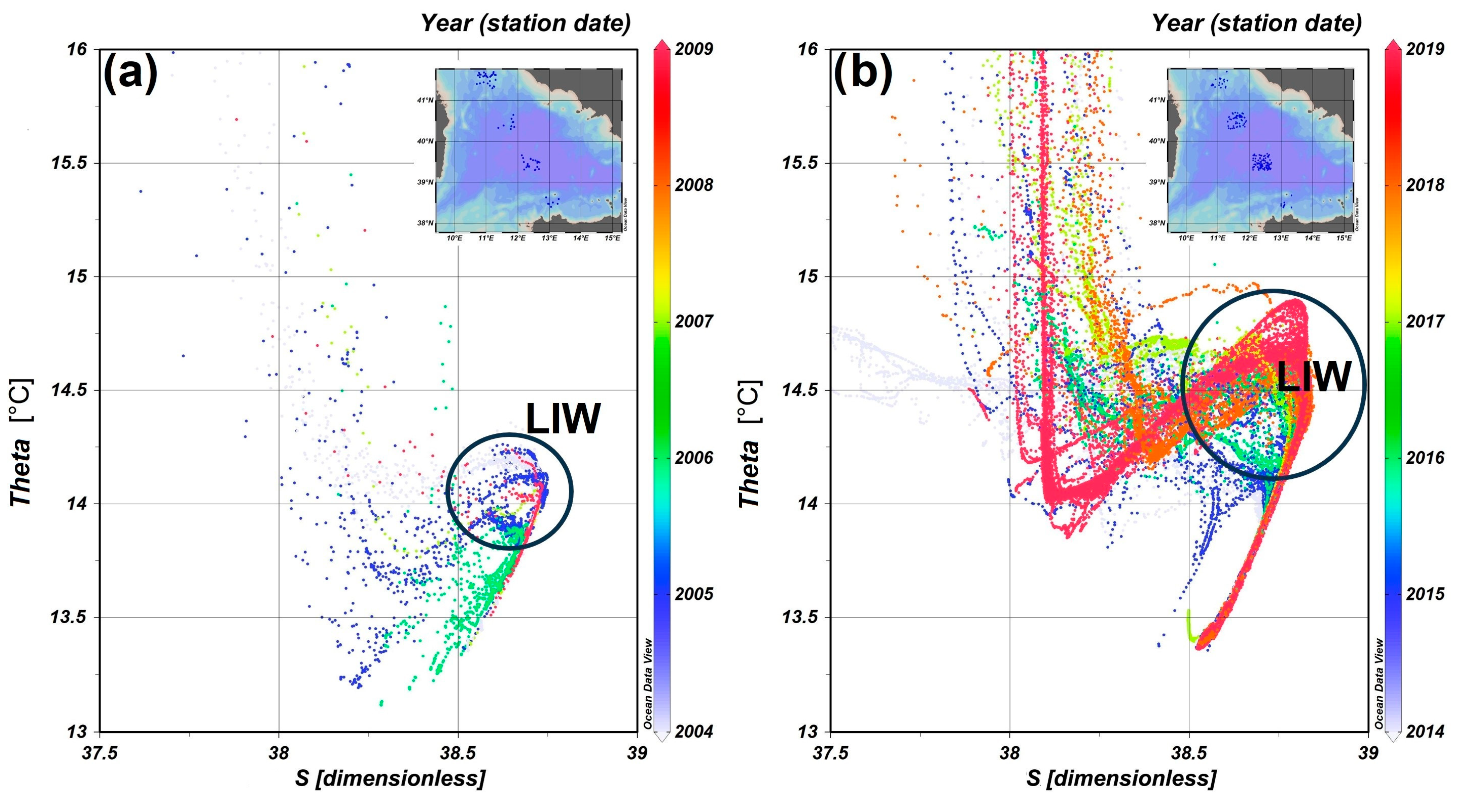
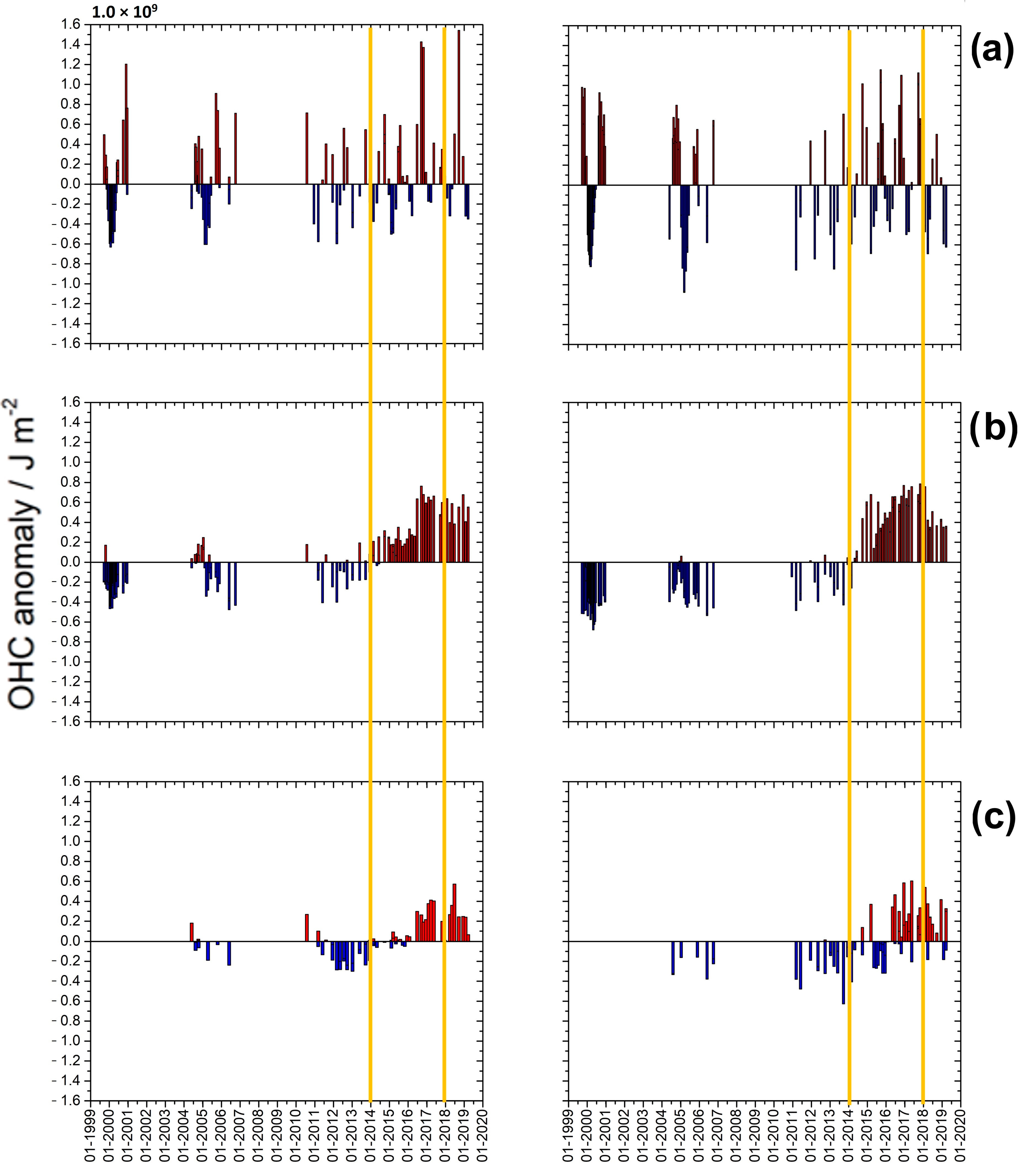

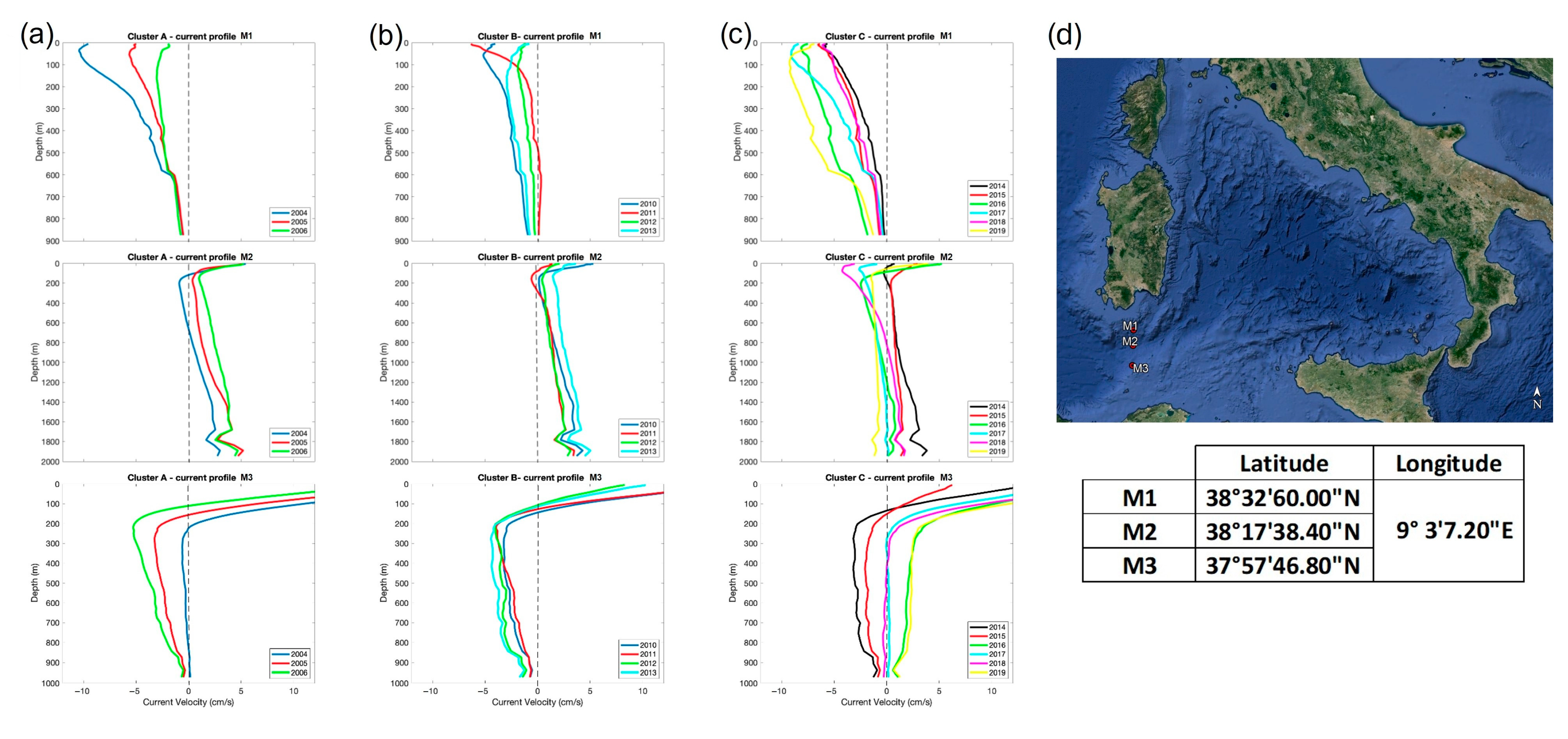
| Year | Month | XBTs/y | |||||||||||
|---|---|---|---|---|---|---|---|---|---|---|---|---|---|
| Jan | Feb | Mar | Apr | May | June | Jul | Aug | Sep | Oct | Nov | Dec | ||
| 1999 | • | • | • | •• | 93 | ||||||||
| 2000 | •• | •• | •• | •• | •• | • | •• | • | • | • | • | 293 | |
| 2001 | 0 | ||||||||||||
| 2002 | 0 | ||||||||||||
| 2003 | 0 | ||||||||||||
| 2004 | • | •• | • | •• | • | • | 164 | ||||||
| 2005 | • | • | • | • | • | • | • | • | • | • | 175 | ||
| 2006 | • | • | 71 | ||||||||||
| 2007 | 0 | ||||||||||||
| 2008 | 0 | ||||||||||||
| 2009 | 0 | ||||||||||||
| 2010 | • | • | 15 | ||||||||||
| 2011 | • | • | •• | • | 82 | ||||||||
| 2012 | • | • | • | • | 85 | ||||||||
| 2013 | • | • | • | • | • | 150 | |||||||
| 2014 | • | • | • | • | • | • | • | 143 | |||||
| 2015 | • | • | • | • | • | • | • | • | 235 | ||||
| 2016 | • | • | • | • | • | • | • | 208 | |||||
| 2017 | • | • | • | • | • | • | 178 | ||||||
| 2018 | • | • | • | • | • | • | 177 | ||||||
| 2019 | • | • | 54 | ||||||||||
| XBTs/month | 201 | 88 | 258 | 84 | 262 | 219 | 55 | 87 | 295 | 218 | 70 | 286 | 2123 |
| WD (m) | #XBTs | |||
|---|---|---|---|---|
| P1 | P2 | P3 | P4 | |
| 10–100 | 179 | 207 | 227 | 219 |
| 100–450 | 169 | 197 | 223 | 204 |
| 450–800 | 80 | 118 | 131 | 98 |
| 800–1500 | NA | 21 | 50 | NA |
Disclaimer/Publisher’s Note: The statements, opinions and data contained in all publications are solely those of the individual author(s) and contributor(s) and not of MDPI and/or the editor(s). MDPI and/or the editor(s) disclaim responsibility for any injury to people or property resulting from any ideas, methods, instructions or products referred to in the content. |
© 2024 by the authors. Licensee MDPI, Basel, Switzerland. This article is an open access article distributed under the terms and conditions of the Creative Commons Attribution (CC BY) license (https://creativecommons.org/licenses/by/4.0/).
Share and Cite
Ciuffardi, T.; Lo Bue, N.; Raiteri, G.; Marullo, S.; Artale, V. New Insights into Tyrrhenian Sea Warming and Heat Penetration through Long-Term Expendable Bathythermograph Data. J. Mar. Sci. Eng. 2024, 12, 1756. https://doi.org/10.3390/jmse12101756
Ciuffardi T, Lo Bue N, Raiteri G, Marullo S, Artale V. New Insights into Tyrrhenian Sea Warming and Heat Penetration through Long-Term Expendable Bathythermograph Data. Journal of Marine Science and Engineering. 2024; 12(10):1756. https://doi.org/10.3390/jmse12101756
Chicago/Turabian StyleCiuffardi, Tiziana, Nadia Lo Bue, Giancarlo Raiteri, Salvatore Marullo, and Vincenzo Artale. 2024. "New Insights into Tyrrhenian Sea Warming and Heat Penetration through Long-Term Expendable Bathythermograph Data" Journal of Marine Science and Engineering 12, no. 10: 1756. https://doi.org/10.3390/jmse12101756







